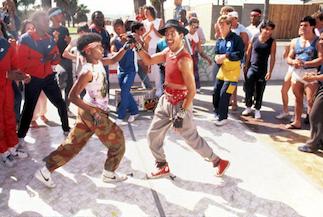|
|
The Number One Movie in America: Breakin'By Sean CollierJune 28, 2020
“Breakin’ 2” was mildly profitable, but debuted in 10th place among a crowded holiday marketplace; it earned $15.1 million total, well under half of its predecessor’s total. “Rappin’” only managed to stay in theaters for a few weeks, pulling in less than $2 million. As much as the original film was a hit and a cultural moment — and it certainly was, with kids from coast to coast attempting to imitate the moves of series stars Adolfo "Shabba Doo" Quiñones and Michael "Boogaloo Shrimp" Chambers — the novelty wore off almost immediately, especially in terms of mainstream box office. The original film is more useful as a cultural artifact than as a standalone film. The main plot is grating (and, unsurprisingly, focused exclusively on the film’s white characters), as traditional dancer Kelly (Lucinda Dickey) livens up her moves by forming a crew with breakdancers Ozone (Quiñones) and Turbo (Chambers). The story is kind of about her fight to get the stuffy Los Angeles dance community to take breakdancing seriously — but it’s mostly about every straight, male character pursuing her romantically. When Turbo and Ozone are left alone to dance (which happens far too infrequently), “Breakin’” comes alive. Oddly, the problem here is not enough dancing; if some of the extraneous scenes (like a bizarre brawl at a country bar) and Kelly-focused developments were excised in favor of more unadorned dance scenes, “Breakin’” would’ve been better than it turned out to be. And “Breakin’ 2” might have actually made some money. “Breakin’” is the subject of the latest episode of The Number One Movie in America, a look back at past box-office champions. Each episode’s film is drawn at random from a list of every number-one movie since 1982. Please listen and subscribe! Next time: It gets the job done, sure, but is it magnificent?
[ View other Number One Movie in America articles ]
[ View other columns by Sean Collier ]
[ Email this column ]
|

|
|
|

|
Friday, November 1, 2024
© 2024 Box Office Prophets, a division of One Of Us, Inc.


